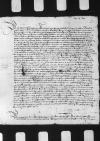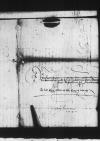List #4975
Albrecht I von Hohenzollern-Ansbach do Ioannes DANTISCUSKönigsberg, 1540-01-11
| odebrano 1540-01-12 Rękopiśmienne podstawy źródłowe:
Pomocnicze podstawy źródłowe:
Publikacje:
| ||||||||||
Tekst + aparat krytyczny + komentarzZwykły tekstTekst + komentarzTekst + aparat krytyczny
Dem Erwirdigenn in Got, unnserem besonndernn liebenn freundt unnd nachbarnn, herrn
Unnser freuntlich dinst zuvornn. /
Erwirdiger in Got, besunder lieber freundt unnd nachbar. /
Nachdem itziger tag unnser diner, / welchenn wir ahnn
Des gleich(en) habenn E(uer) L(ieb) hiebey, wes dismals fur zeittung ann unns gelangt zuvornhemenn. / Welche wir E(uer) L(ieb) weil wir dieselb gleichsfals in allem zimlichenn gegenn unns unnd denn unnsernn gemeint wissen nicht vorhaltenn wollenn.
Dieweil wir auch befindenn, das aus ursachenn, welche zuvorczelen unnotig, unnd E(uer) L(ieb) solche besser dann wir inmer schreibenn khonnenn zuerwegen wissenn vormutliche wurung in diesenn armenn landenn
Dieweil aber wir E(uer) L(ieb) unnd die loblichenn stendt als mit vether und vorseher dieses armenn lands vonn Goth vorordent, unnd sichs auch derhalben, / unns und E(uer) L(ieb) auff solchs unnd anders wes gemeinenn landenn zu abbruch unnd nachteil bechicht, / guthe und vleissige auffsehenn / unnd solchem ablennng zuthun gepurenn will, / so habenn E(uer) L(ieb) als der hochvorstendige bea stain⌈[bea]bea stain⌉ chtlich zuermessenn. / Wo die ausfhur des getreide gestattet, must ihe volgenn, das diese landt welche ohne das im vorgangnenn sommer durch vilfeltige ausfhur mit allerley getreydich sehr entplost / unnd dardurch dem armenn welcher sonst auch mit grostenn zinsenn scharwergk unnd andern beschwerungen beladenn teurung auffgelegt, / des wo es gescheenn solt zuerbarmenn. /
Demnach ist ahnn E(uer) L(ieb) unnser gantz freuntlich unnd nachbarlich bith, E(uer) L(ieb) wolle dise hohe bedrengliche notturfft dieser lanndt / als der mitregent / bedenckenn erwegenn unnd dis einsehenn fur sich selbst in dem irenn thun / unnd bey yrenn mitvorwanthenn den herenn
Dat(um)
Vonn Gotts gnadenn


 BCz, 1606, p. 302
BCz, 1606, p. 302